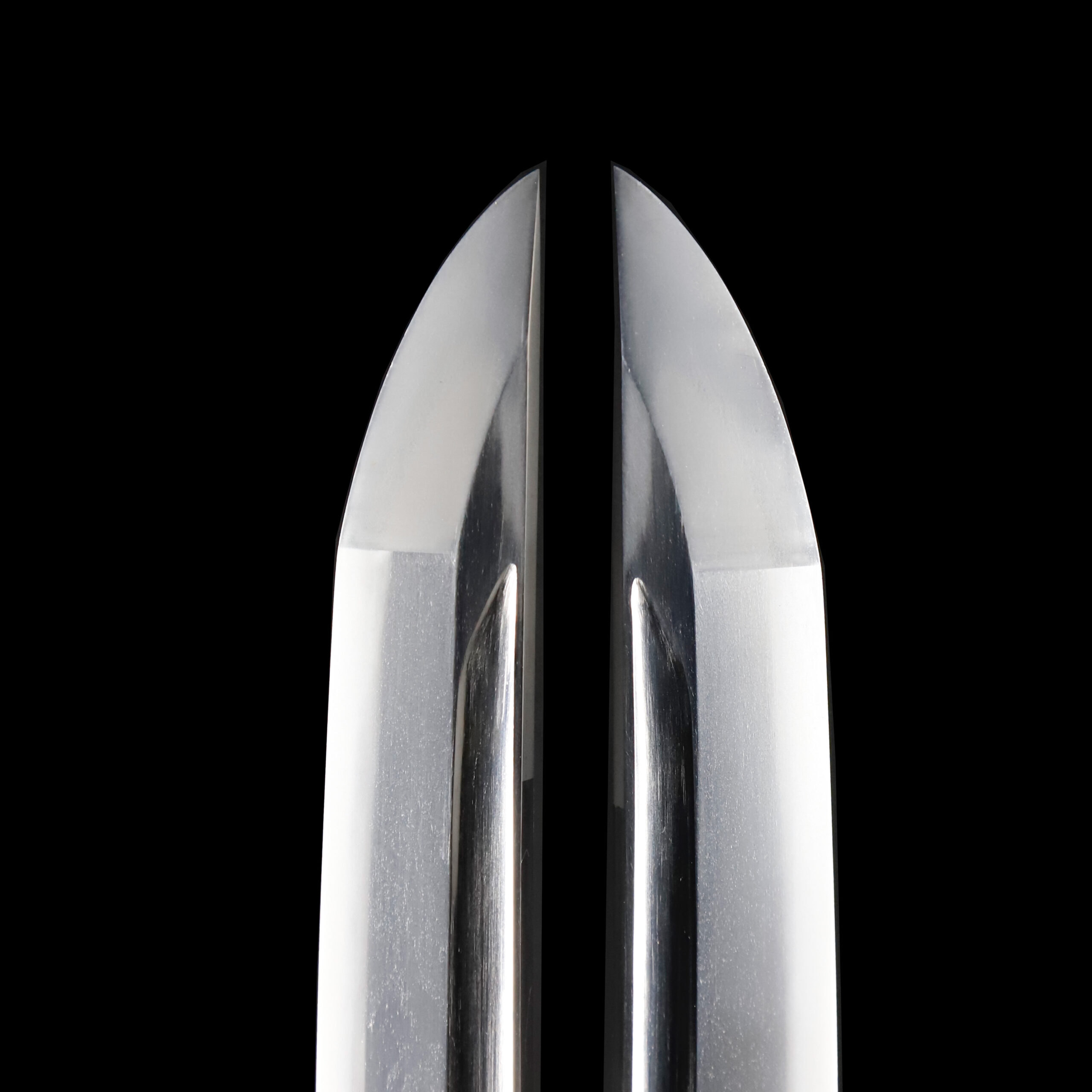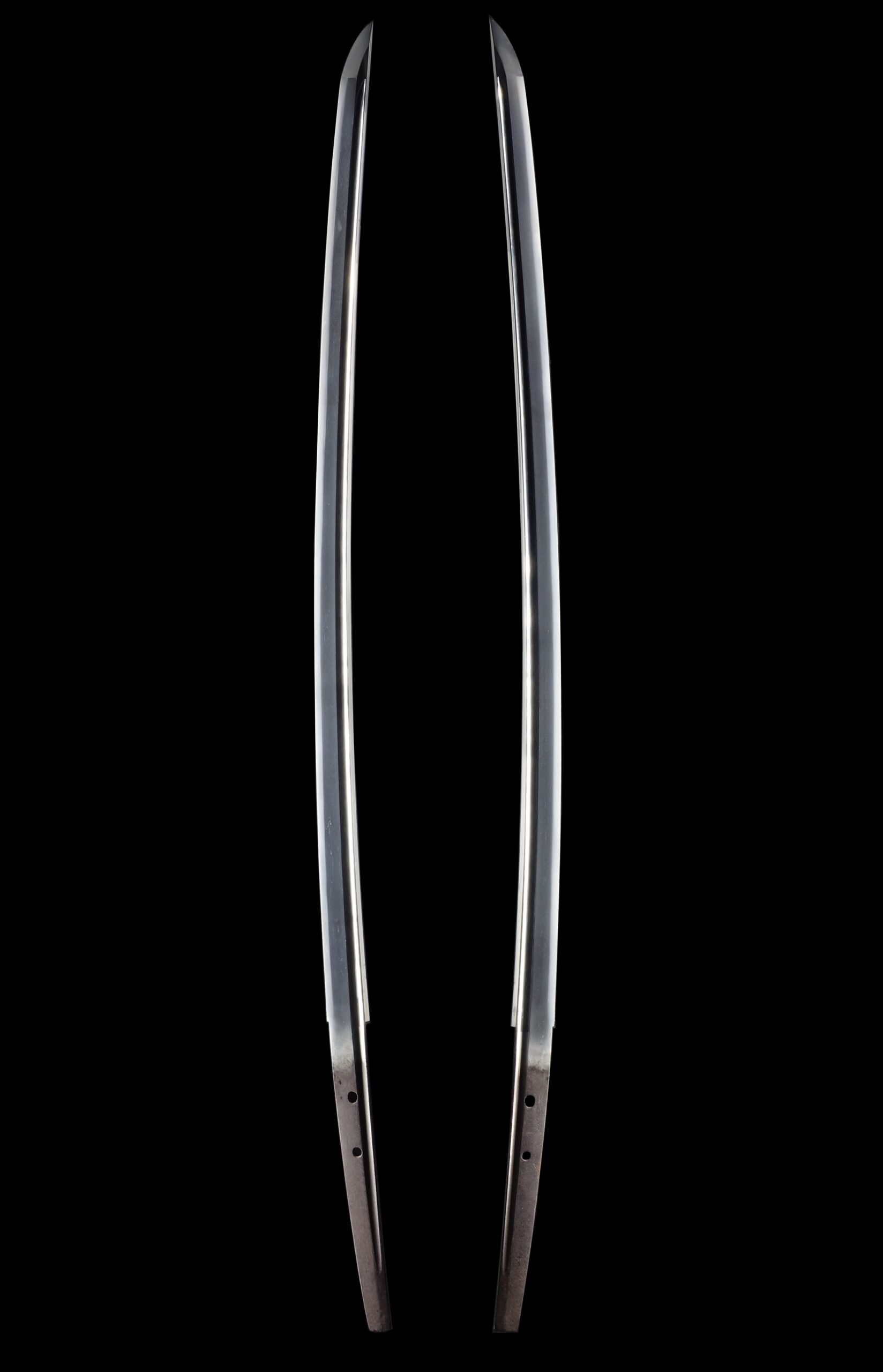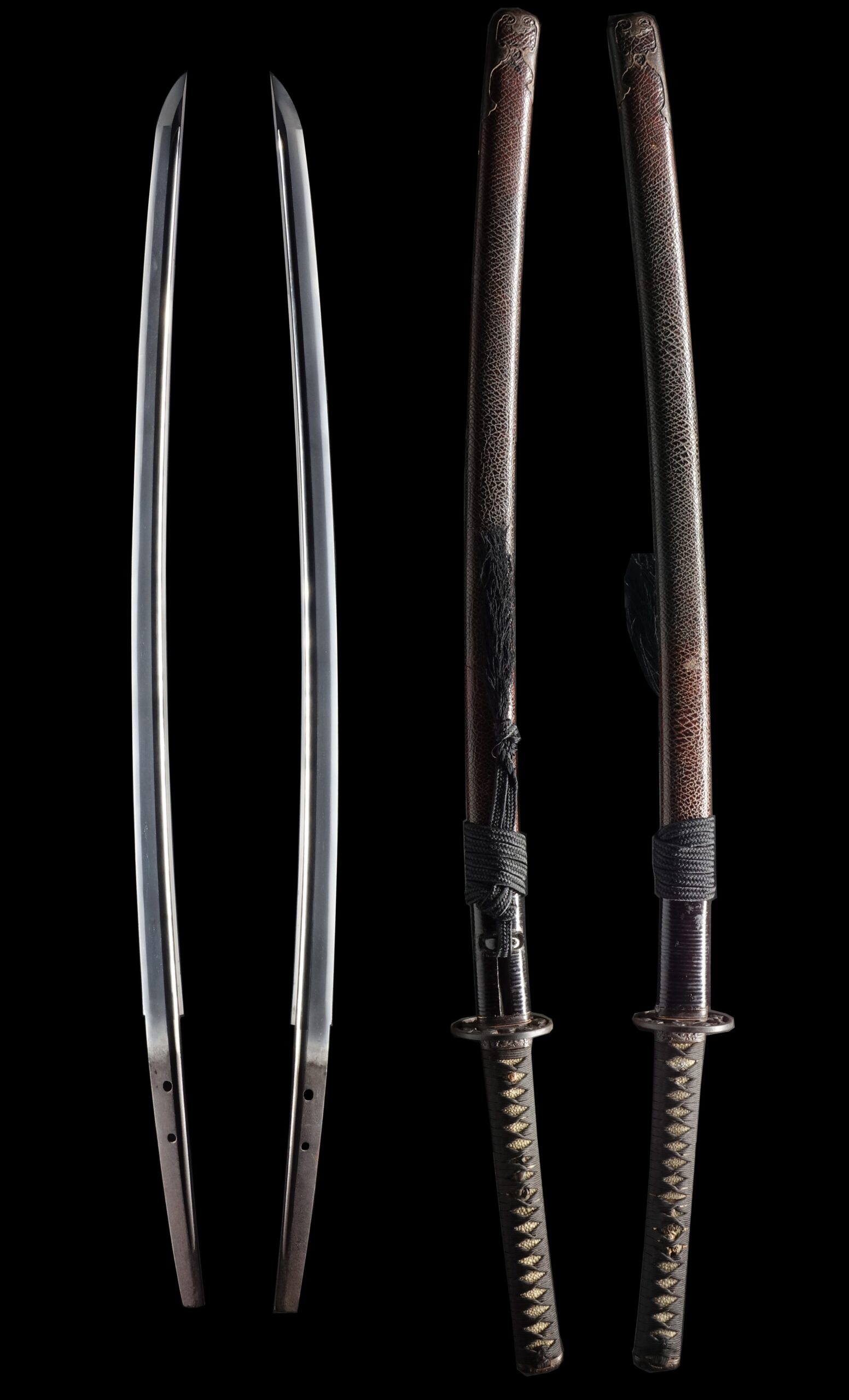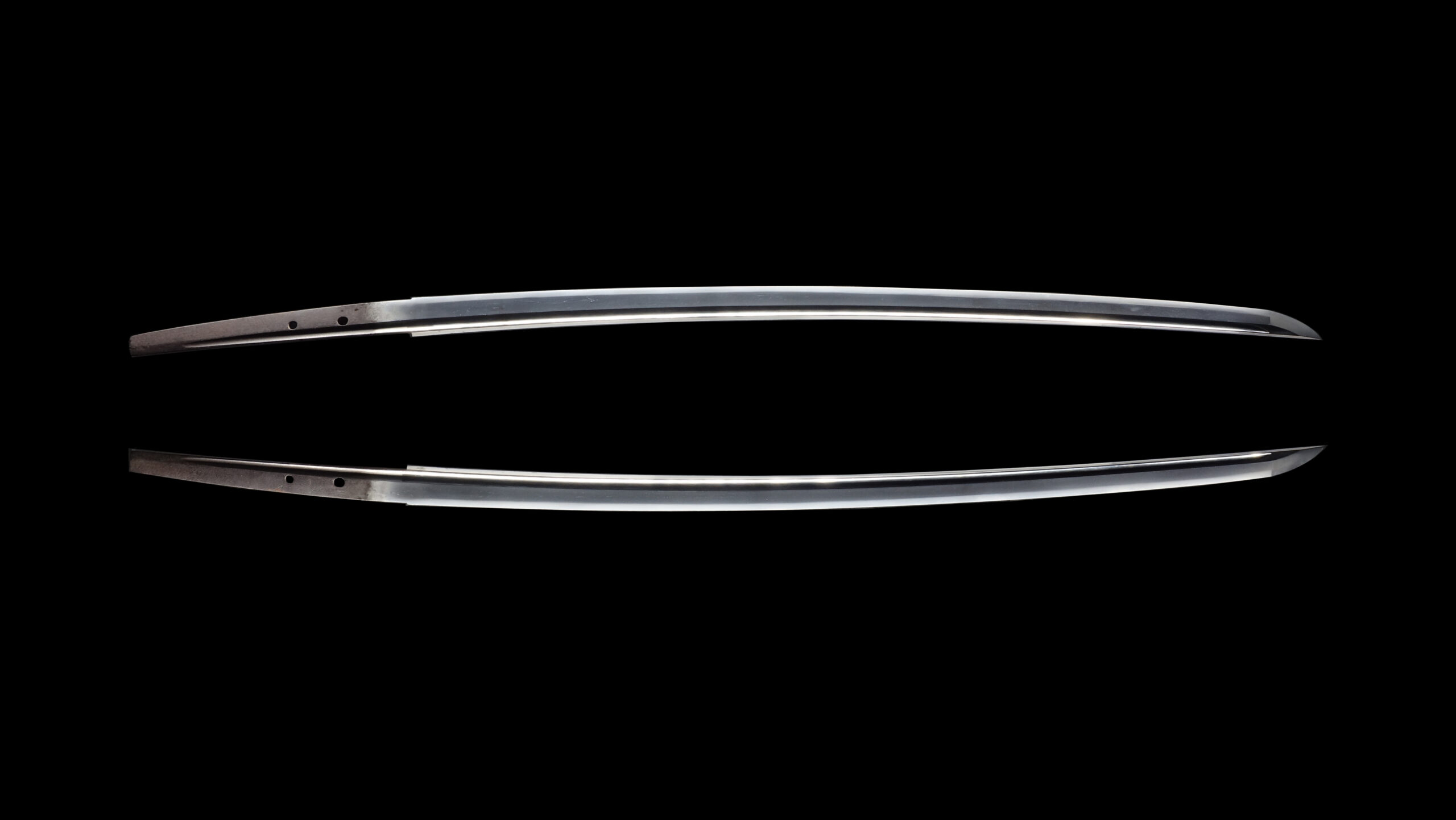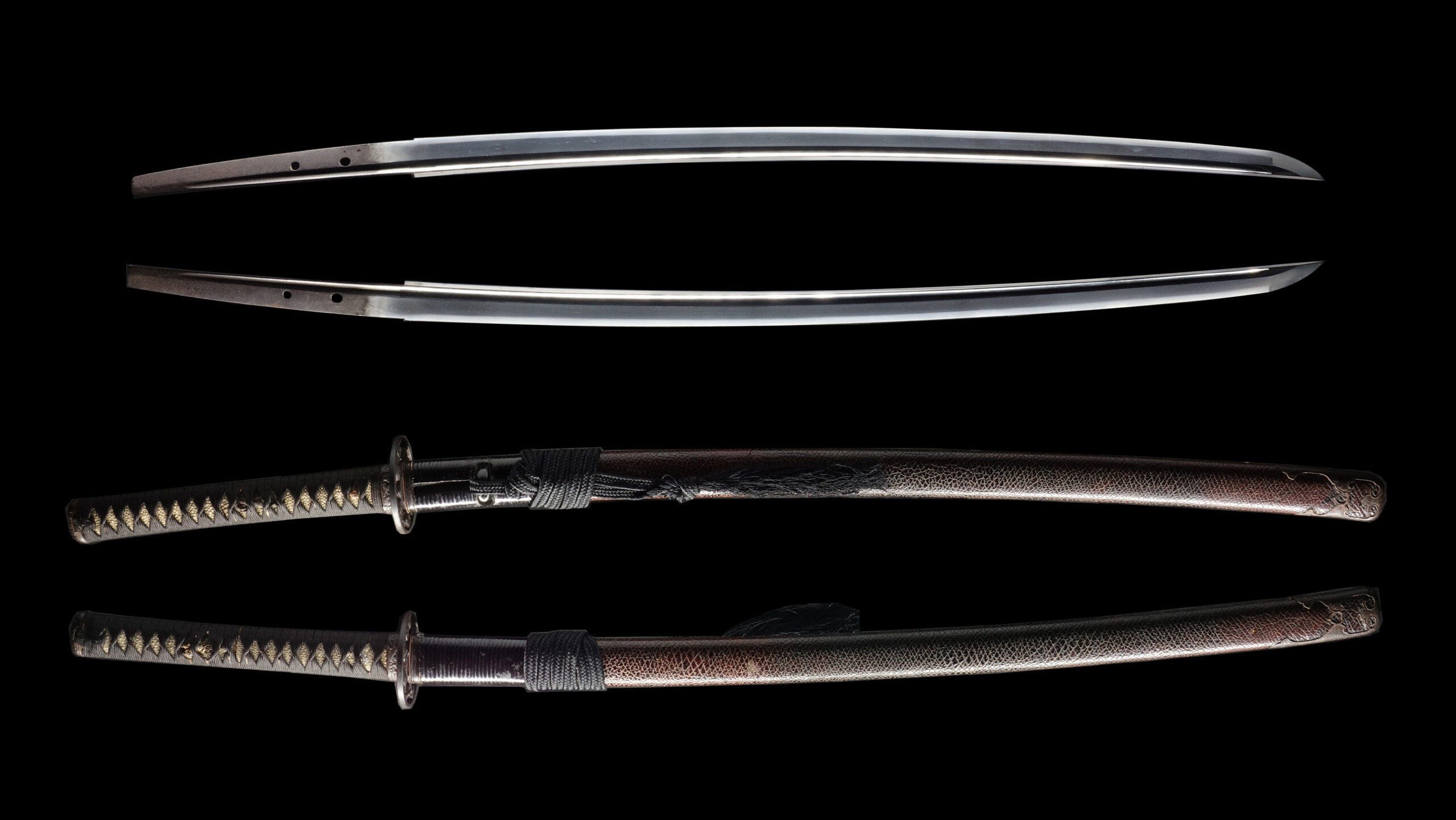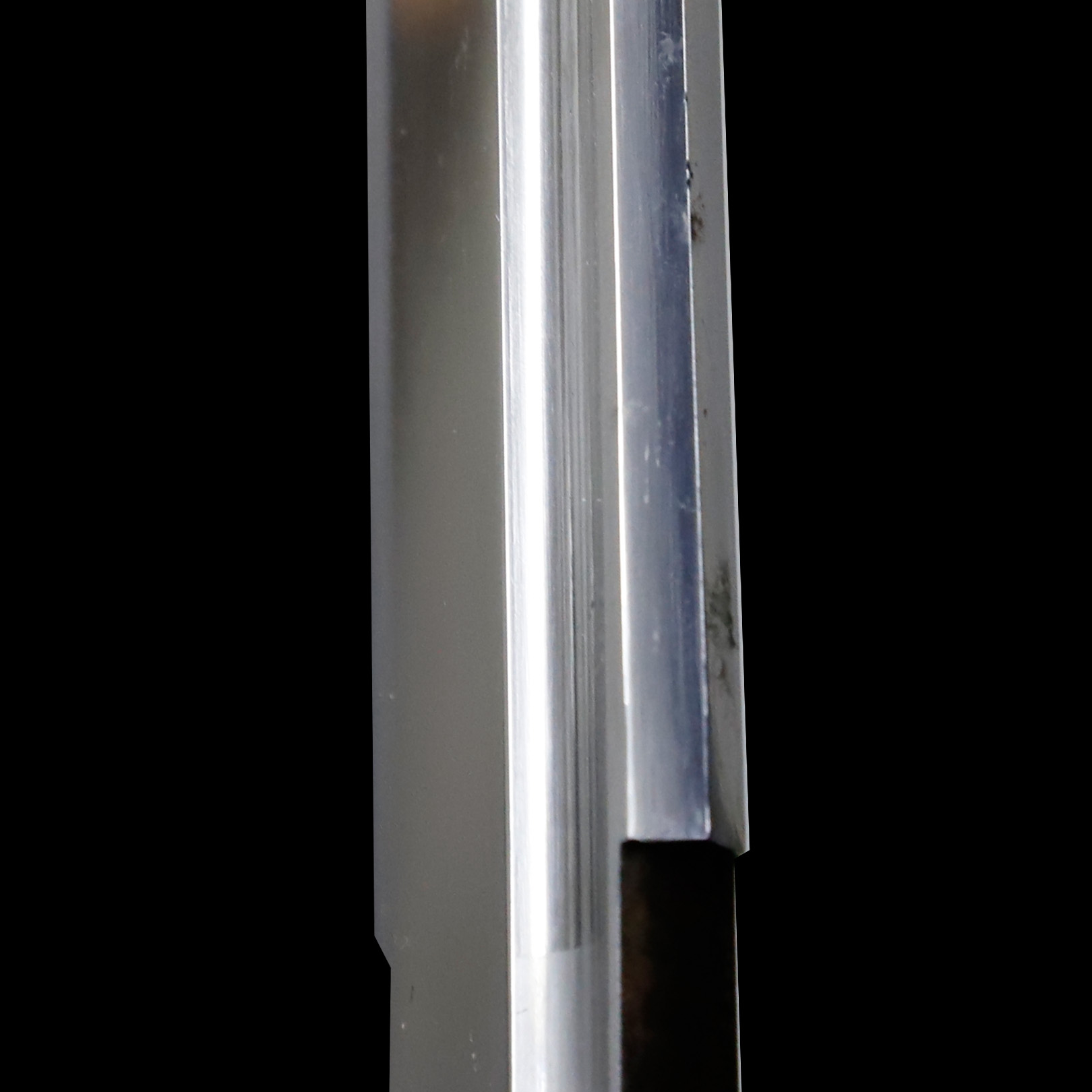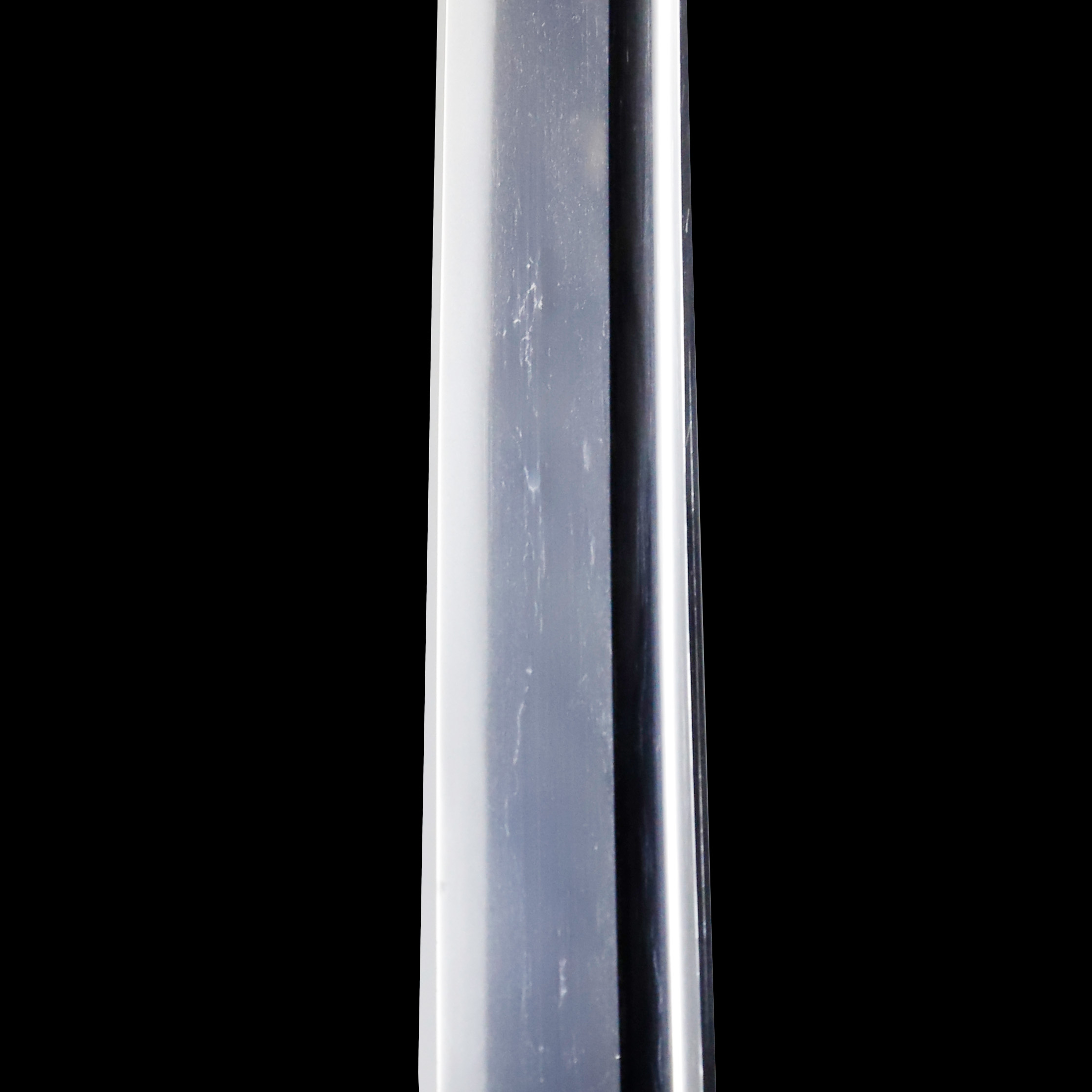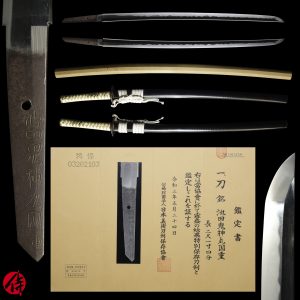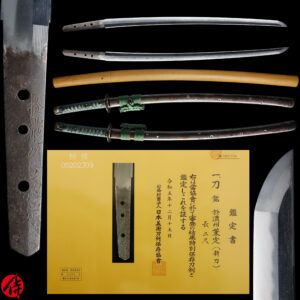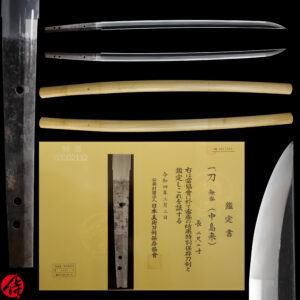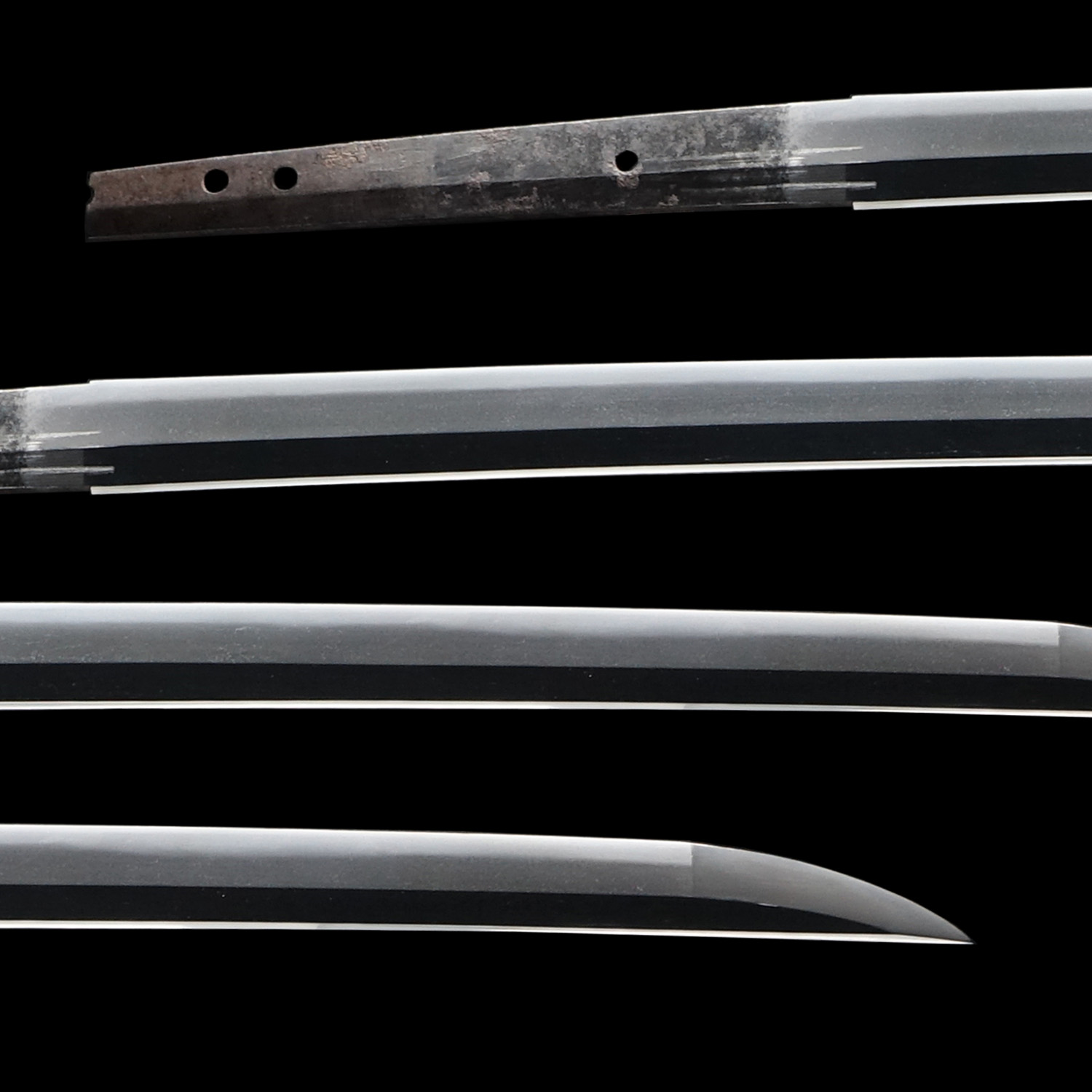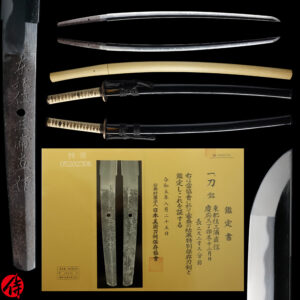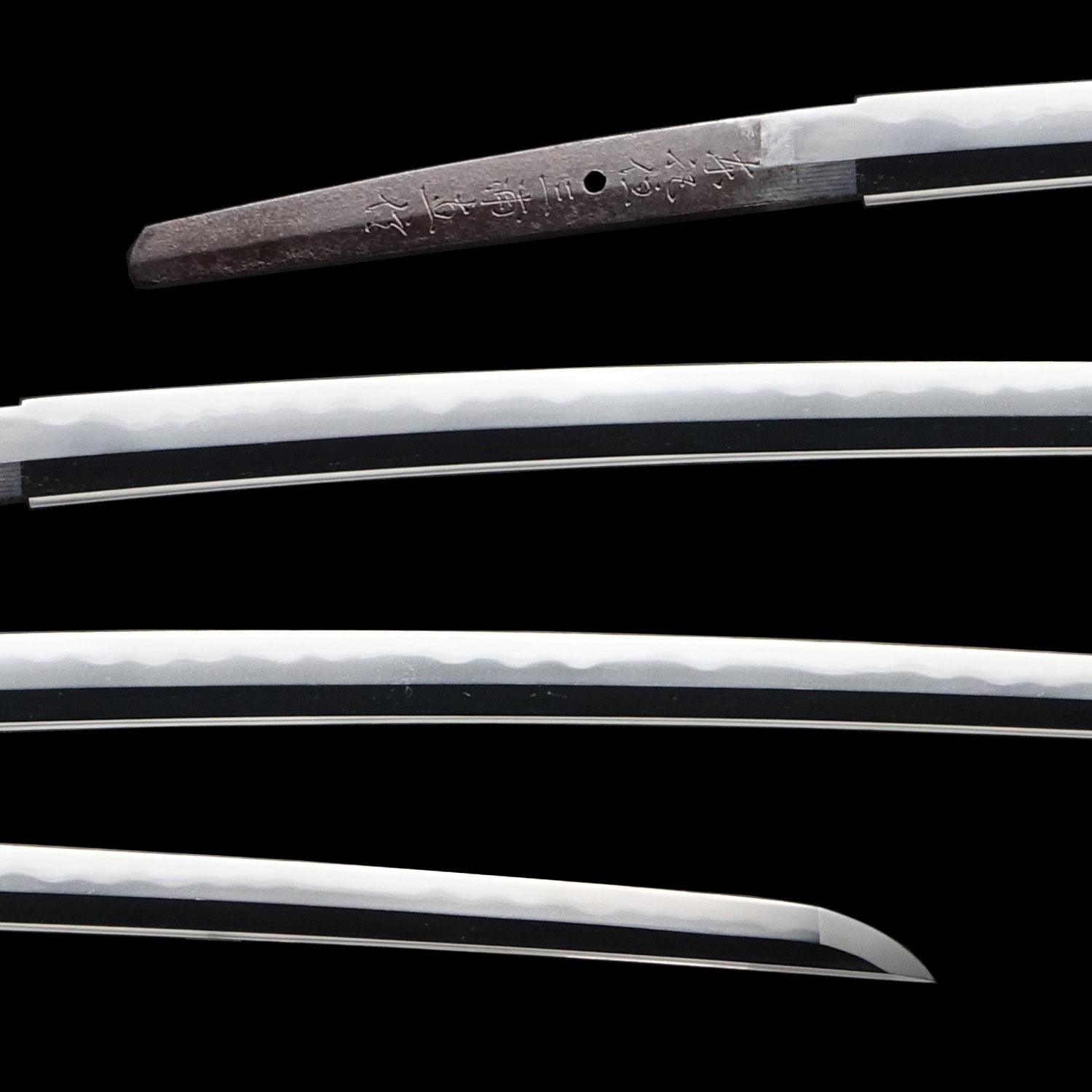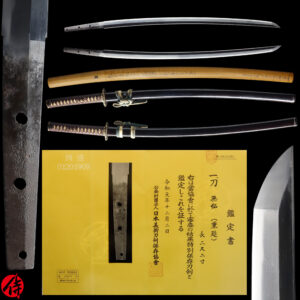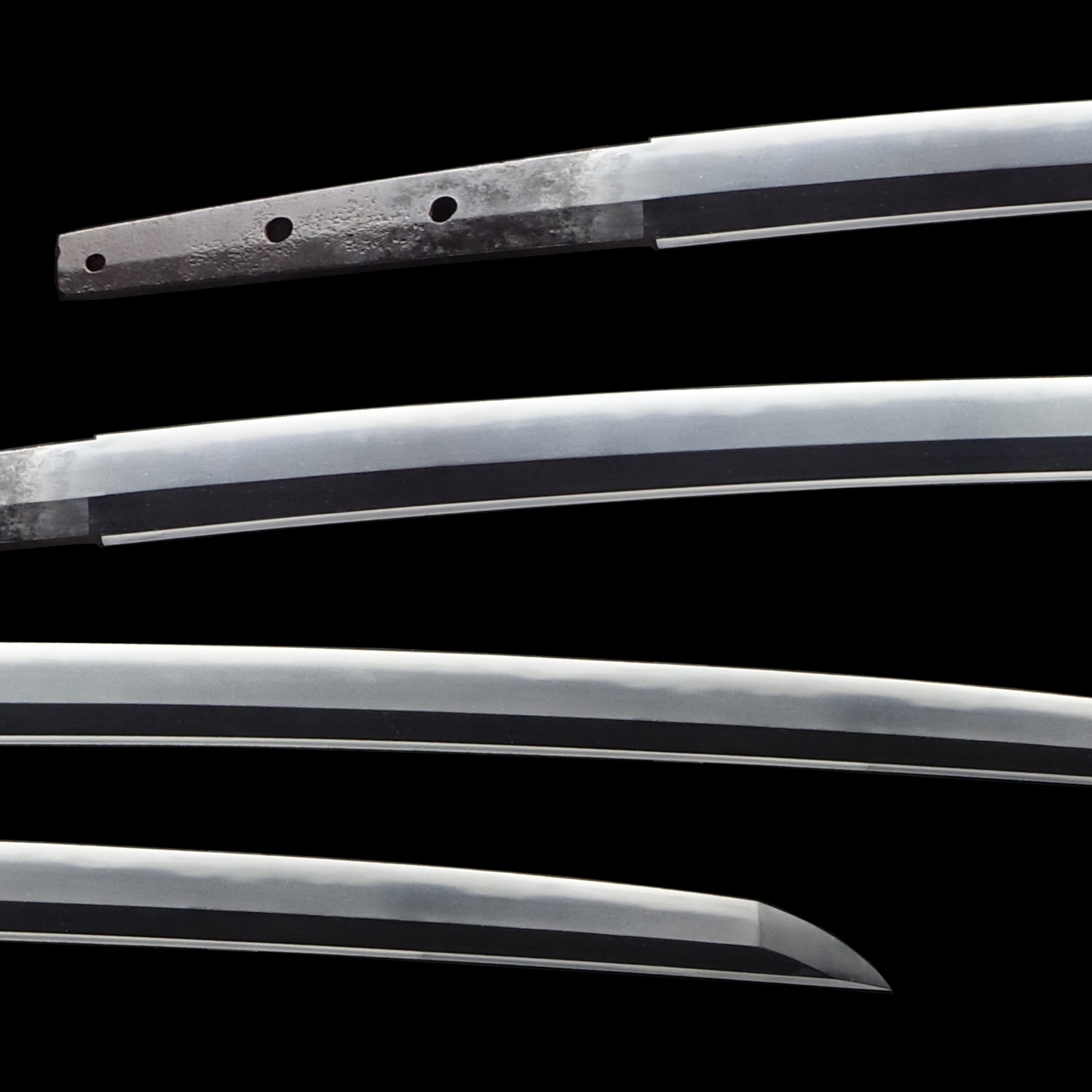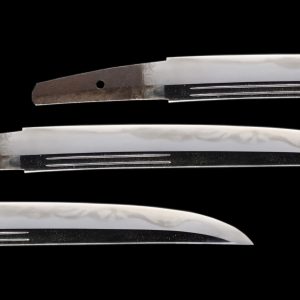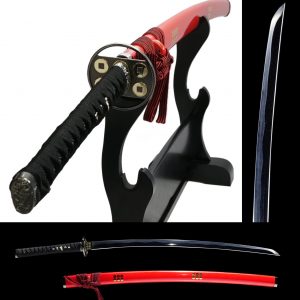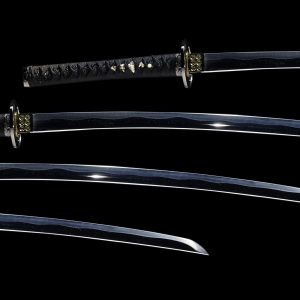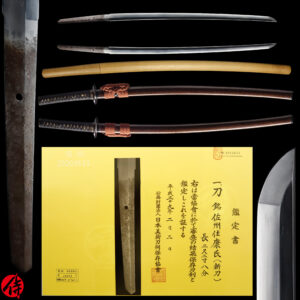Antique Japanese Sword Katana attributed to Musashi Daijo Fujiwara Tadahiro with NBTHK Hozon Certificate
【Description】
This blade is attributed to Musashi Daijo Fujiwara Tadahiro (武蔵大掾藤原忠広). This maker’s name was used by the first-gen Tadayoshi in his career. Hizenkoku is the province’s name in today’s Saga prefecture on Kyushu island. The first-gen Tadayoshi is considered one of the most renowned swordsmiths during the early Edo period. Also, the maker’s name, Tadayoshi, lasted many generations throughout the Edo period.
He was born in the third year of the Genki era (1572: Late Muromachi period) as the son of Hashimoto Michihiro. Tadayoshi’s birthname was Hashimoto Shinzaemon. It is said that Hashimoto family had Samurai lineage and served Ryuzoji Daimyo (feudal lord) as a retainer for generations on Kyushu island. However, in 1584, his grandfather Morihiro and Father Michihiro were killed in a war called Okinawa-te no Tatakai, where Ryuzoji clan fought against Shimazu clan. Therefore, Hashimoto family couldn’t keep serving the clan and status of Samurai because Tadayoshi, the head of the family, was just 13 years old.
The whole family turned the new leaf. Tadayoshi was supported by Dotanuki Zenbei, who was related to Tadayoshi and had served Kato Kiyomasa, a legendary warlord during Sengoku Jidai (Warring state period). It is said that he learned sword-forging techniques from Zenbei for about 13 years.
In 1596, under the domain’s order, he went to Kyoto to learn the sword-forging techniques from Umetada Myojyu(埋忠明寿), one of the greatest swordsmiths in the early Edo period. Tadayoshi improved his craftsmanship and returned to the Saga domain three years later (1598). The first head of the Nabeshima clan, Nabeshima Katsushige, appreciated the work of the first-gen Tadayoshi very much. Then, Katsushige appointed him as his Okakaekaji, a swordsmith who exclusively forged swords for a specific domain or clan. And Tadayoshi started to stay near Saga castle, which was the headquarter of the Nabeshima clan. Then, he founded his school, which trained more than 100 swordsmiths during the Edo period. His outstanding skills were passed to the generations of Tadayoshi and among apprentices.
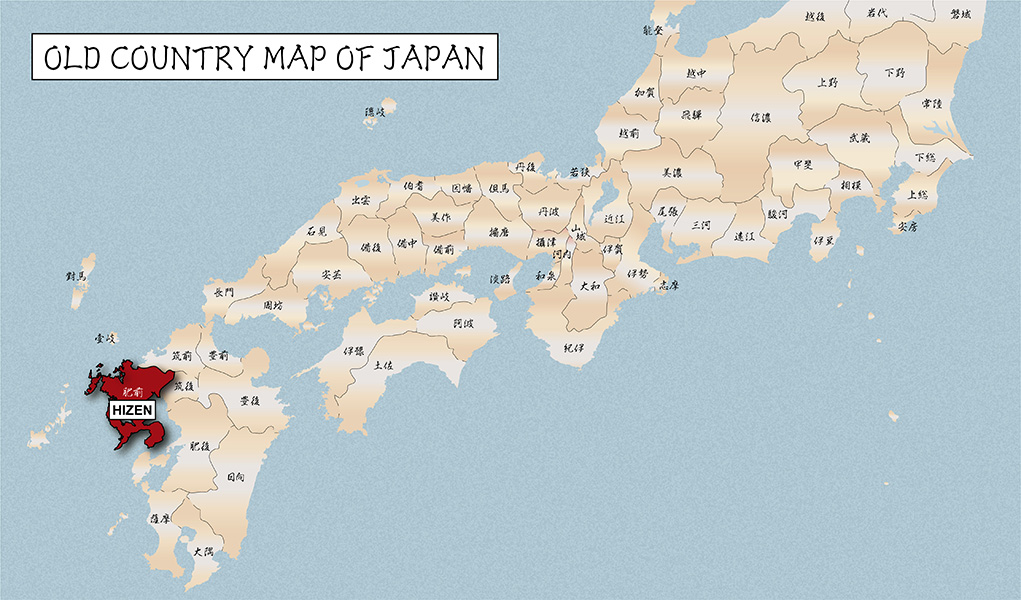
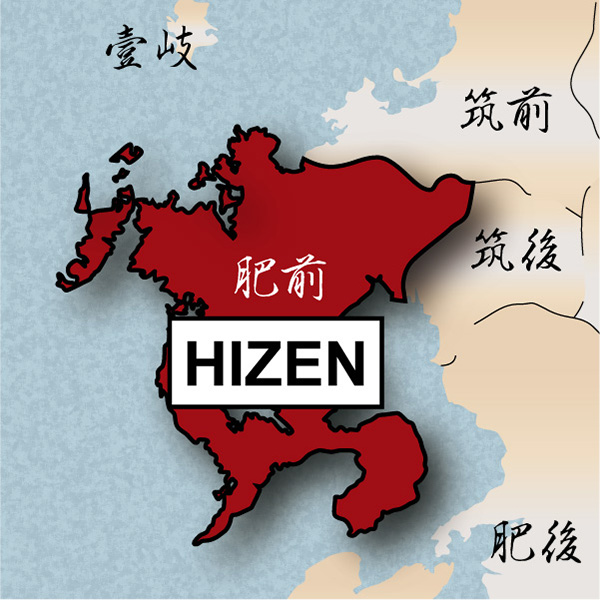
According to available records, the earliest work he signed his signature with the year is the 5th year of the Keicho era (1600), when he was 29 years old. Interestingly, he revisited Kyoto in the 10th year of the Genwa era (1624) and received an honorable official title of Musashi Daijyo on Feb 18th from the emperor for his excellent craftsmanship. And, he changed his name to Tadahiro. He made 4 different signatures during his career. They are Hizen Koku Shinzaemonnojo Tadayoshi , Hizen Koku Junin Tadayoshi, Hizen Koku Jyu Fujiwara Tadayoshi and Musashi Daijyo Tadahiro. He was active in sword-forging for about 30 years. And he died in the 9th year of the Kanei era (1632).
The swordsmiths in the Hizen province worked under the auspices of the Nabeshima clan like Tadayoshi. They could produce beautiful blades with Konuka Hada, whose steel surface is very smooth. This Hada is one of the most well-known characteristics of the blades produced in Hizen province. The swordsmiths also used and mixed carbon steel made in western countries. Since Hizenkoku had been flourishing through international trading, it had easy access to western carbon steel.
This blade is appraised as a Hozon Touken (保存刀剣) issued by NBTHK (Nihon Bijutsu Touken Hozon Kyokai: 日本美術刀剣保存協会). This authentication paper was only given to authentic Japanese swords, well preserved and high quality with artistic value.
Please keep in mind that there are a couple of black rust on the Mune (backbone) of this blade. If you like to see the detailed condition before placing an order, please make sure to ask us to send you additional photos first.
【Blade】
Cutting Edge Length (Nagasa): 71.8 cm ( 28.2 inches)
Curvature (Sori): 1.4 cm (0.55 inches)

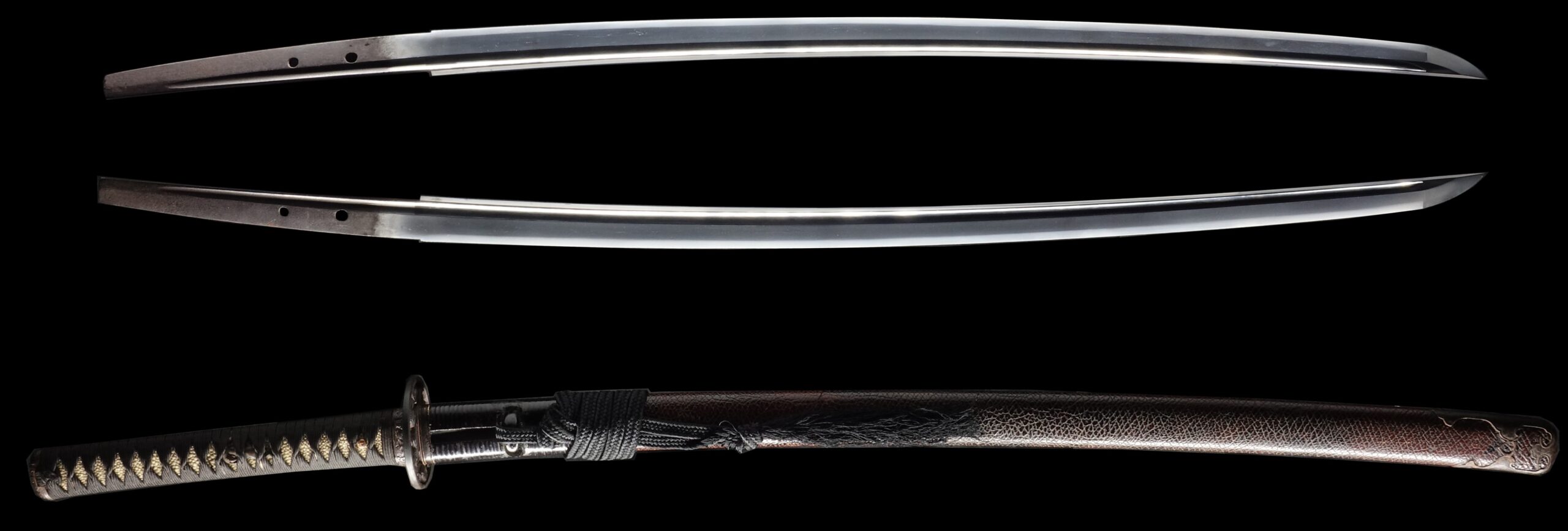
Hamon:
The crystalline structure which forms along the cutting edge of a blade as a result of the hardening process.
Jimon (Jihada):
Visible steel surface pattern created by folding and hammering during forging process.
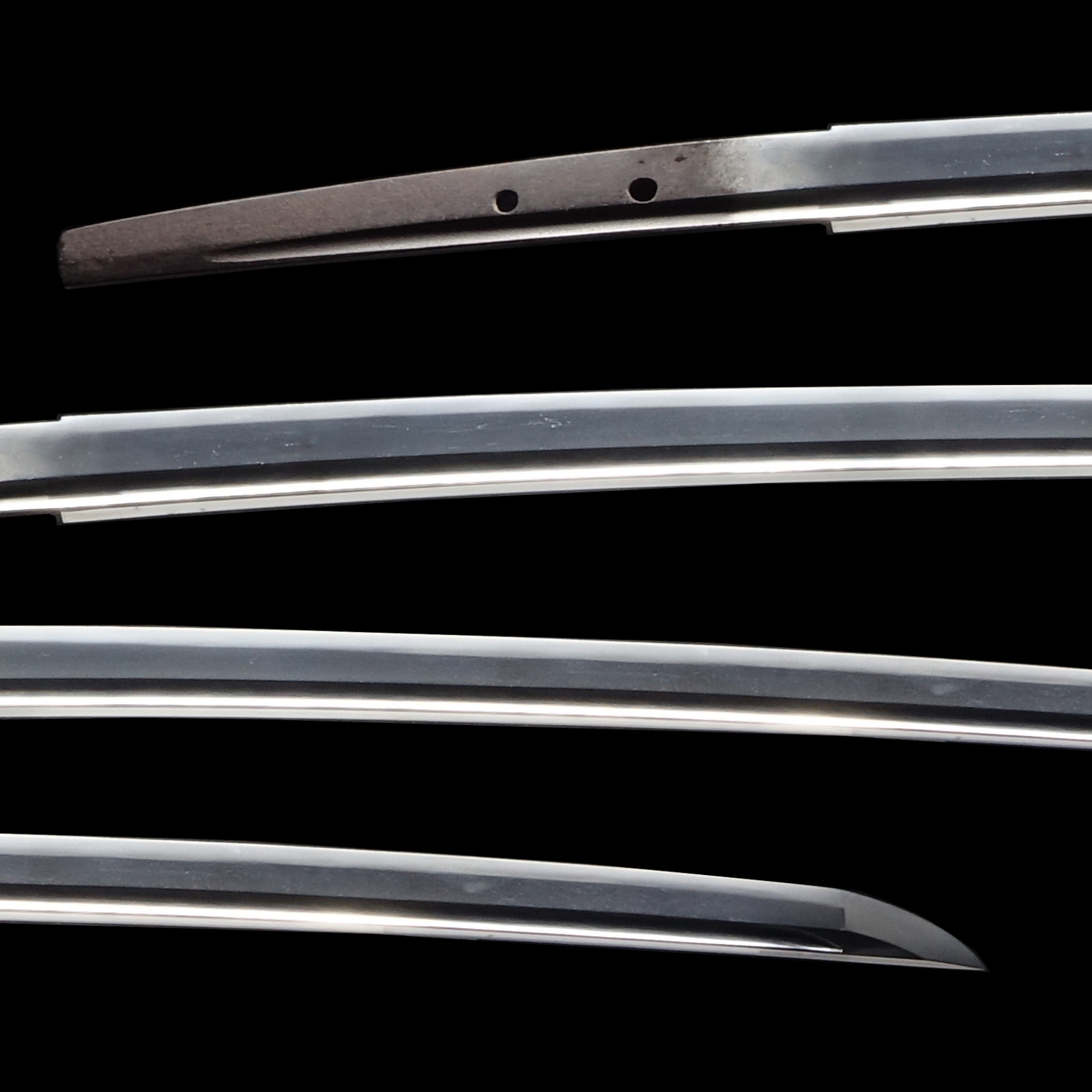
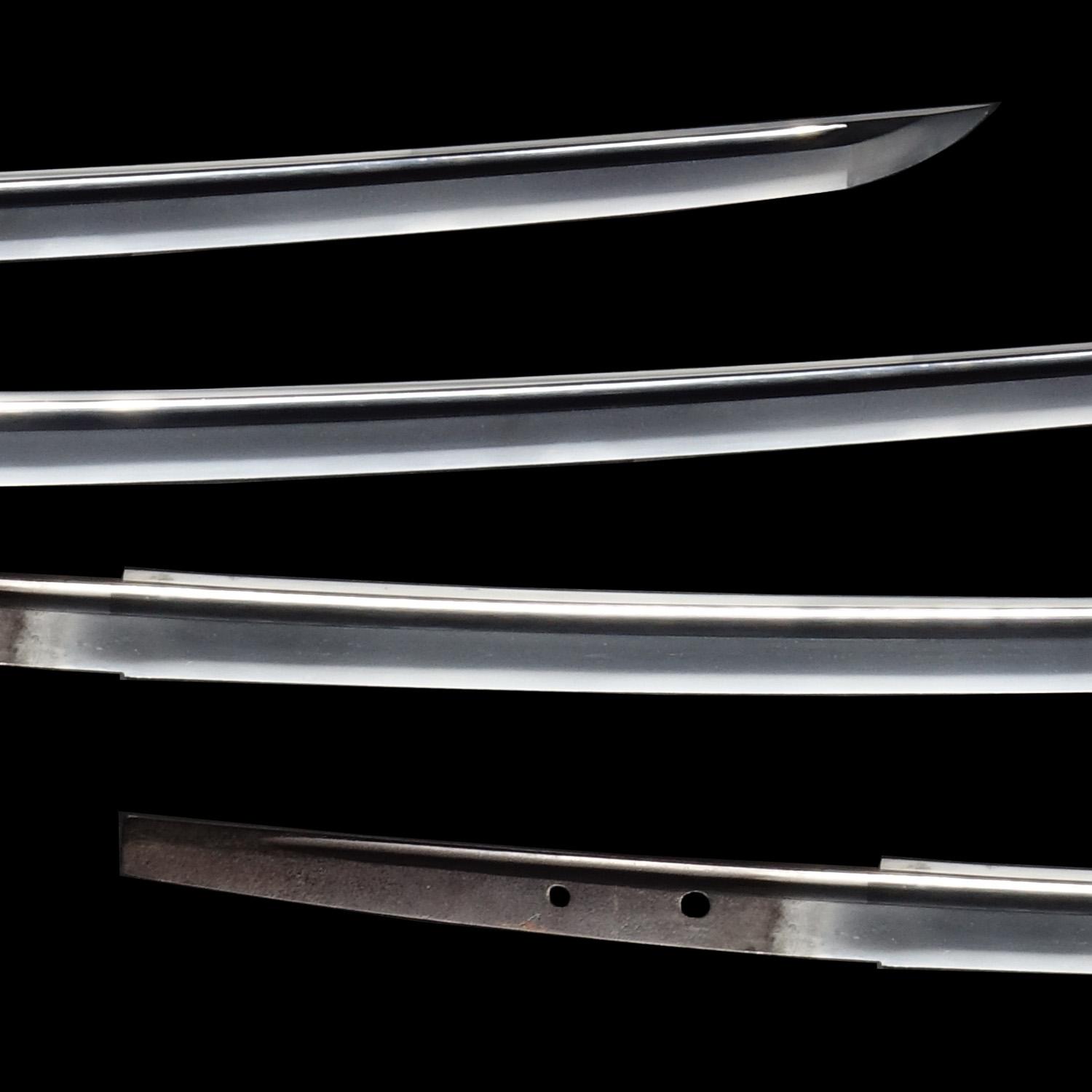
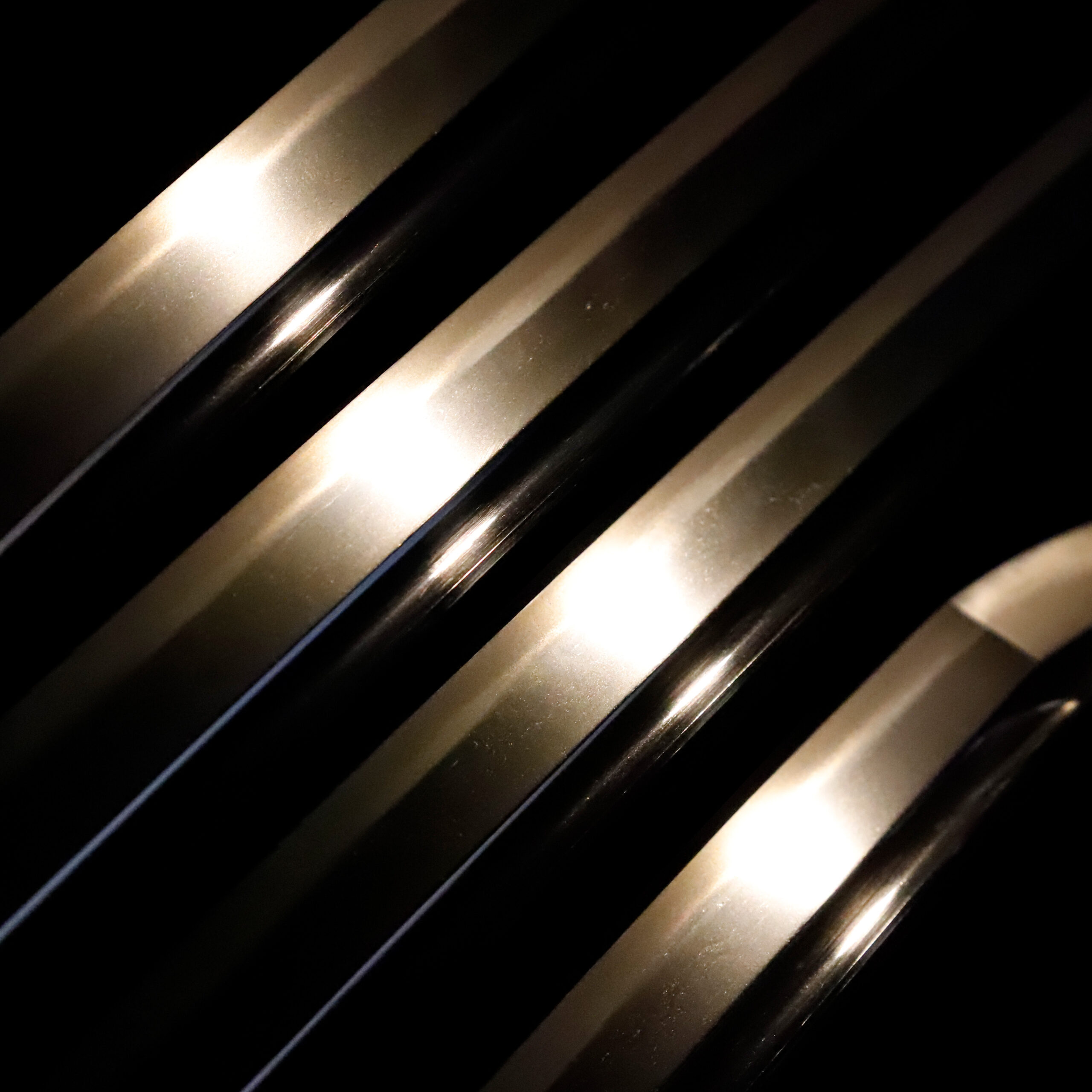
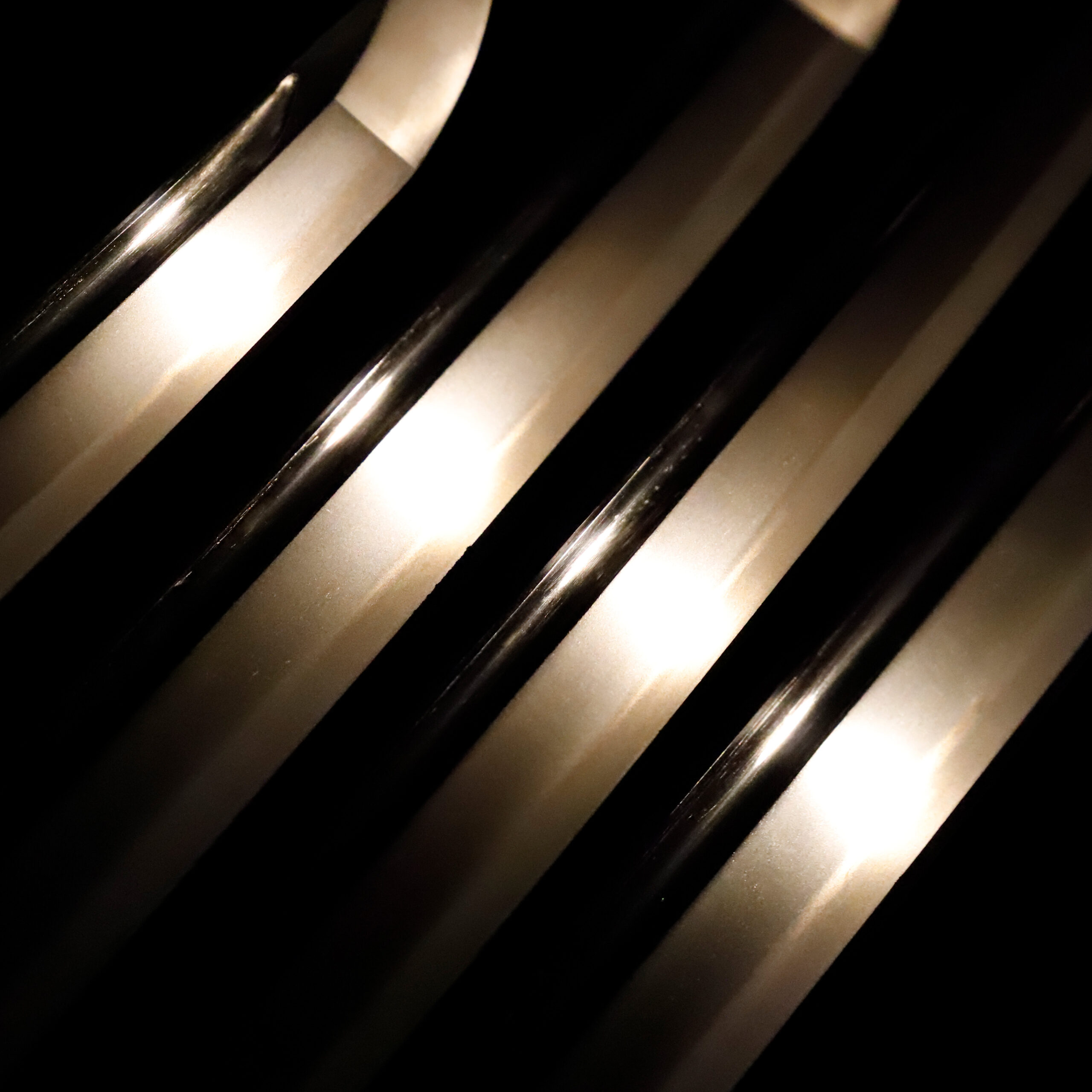

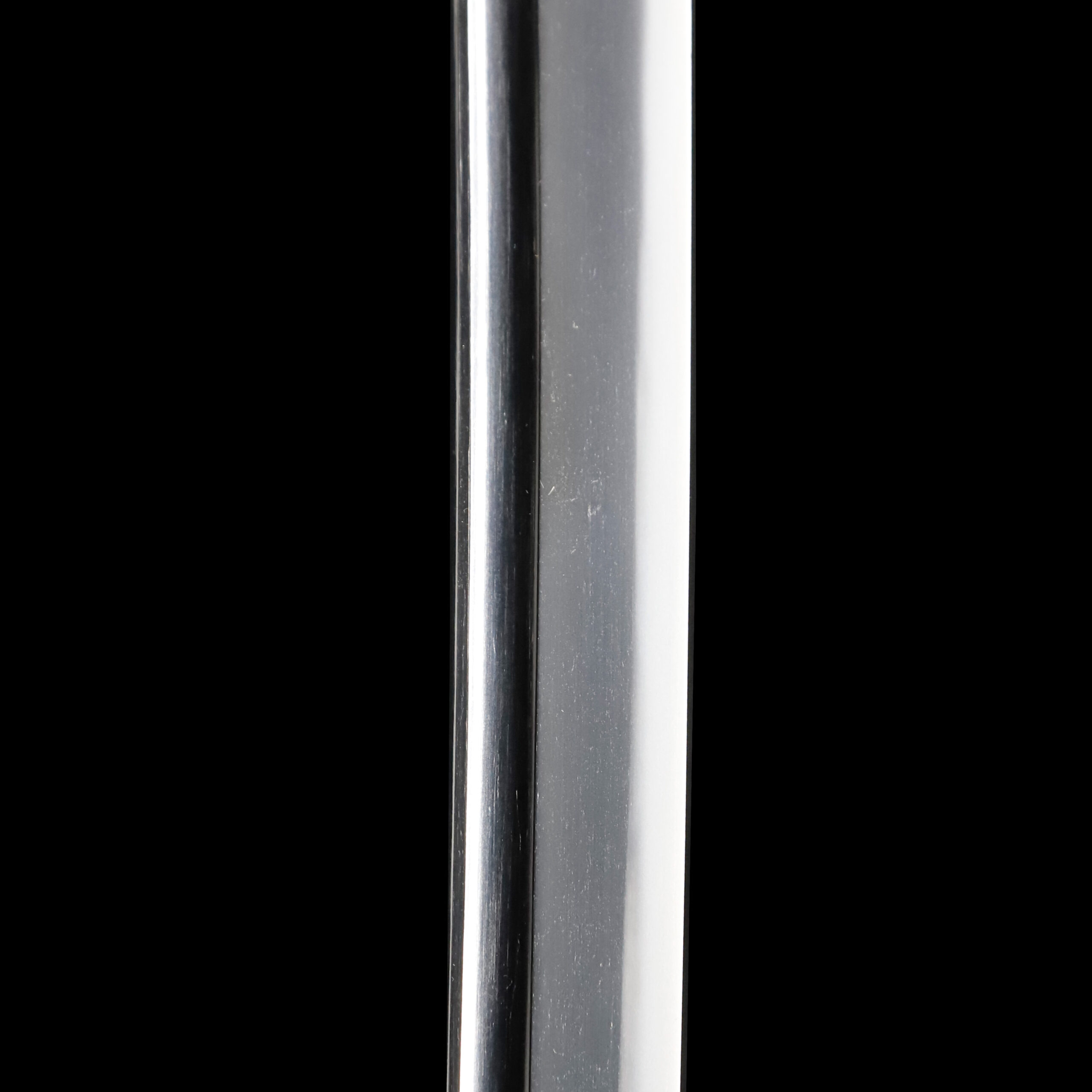
Kissaki: Kissaki is the tip of the Japanese sword.

Nakago: Nakago is the tang of the Japanese sword.
Japanese swordsmiths left the black rust on the tang because it prevents red rust while the tang is in its handle. And the discoloration of the tang was created over time, and it is a great indicator for a Japanese sword specialist to estimate when the sword was forged.

Koshirae: Koshirae is the mounting of the Japanese sword. There are several parts that consist of Koshirae such as Saya (Scabbard), Tsuka (Handle), Tsuba (Handguard).

Fuchi-Kashira: A pair of matching sword fittings that cover the upper and bottom parts of its sword hilt.
Since the surface is worn due to aging, it is challenging to judge the detailed design: we think a rabbit is engraved on the Kashira part. The Kanji letter for a rabbit is written as “兎” in Japanese. Since the shape of this character is similar to the Kanji “免 (it means avoid),” it is said that this animal design wards off bad luck and misfortune. In addition, rabbits have high reproductive ability, so it is a symbol of offspring prosperity and safe delivery. And the figure of a rabbit jumping forward is a symbol of “things will be solved without problems.” This animal is closely related to the moon, as there is the idea that there is a rabbit on the moon.
There is an idea that there are rabbits on the moon. The moon is read as “Tsuki (月),” and the expression “ツキがある (Tsuki-ga-aru),” which means “having luck,” could be found. This is also one of the reasons why rabbits have been treated as auspicious existences.

Tsuka and Menuki: Tsuka is the handle of the Japanese sword and Menuki is its decoration.
The same as the Fuchi Kashira we focused on above, this Menuki is also challenging to distinguish this Meunki’s motifs. We could find a figure of an animal with curly hair at the lower side Menuki. And we assume it is probably a Karajishi (唐獅子). The Shishi (獅子) means a lion in Japanese, and the Karajishi is a lion brought from the Continent to Japan in the Toh period (唐, Tang dynasty, 618-907). Karajishis typically have curly hair for their head, neck, body, and tail. In Buddhism, the Karajishi is regarded as a symbol of wisdom, and the Monju Bosatu (文殊菩薩, Manjushri Bodhisattva) rides lions. According to a theory, the Kara-Jishi originates from the Komainu (狛犬, stone guardian dogs that exorcize evil spirits).
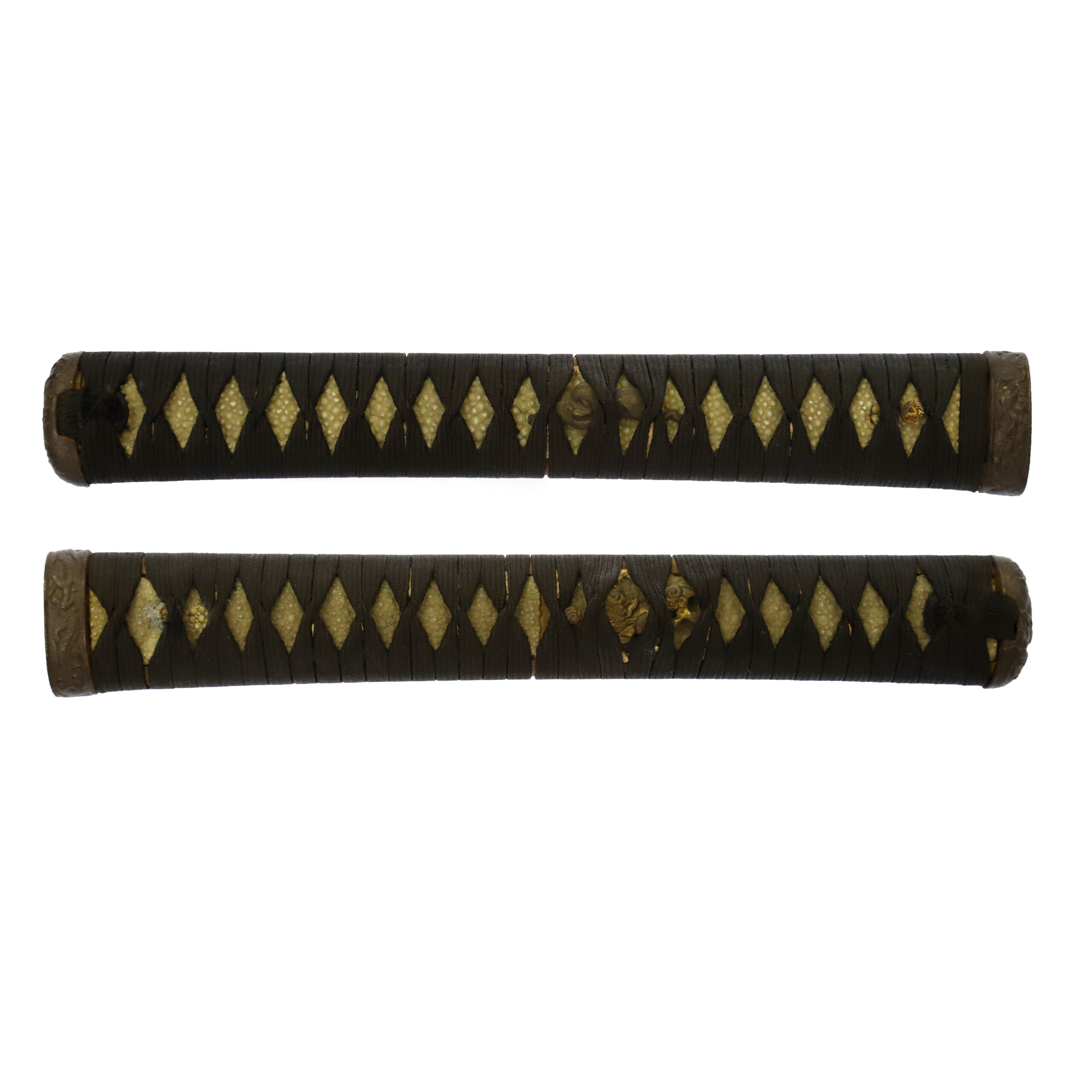

Tsuba and Habaki: Tsuba is the handguard for the Japanese Sword and Habaki is the equipment to make the blade not touch its scabbard inside. It prevents the blade from getting rusty and chipped.
We estimate this Tsuba’s design is a combination of the motifs related to the Fujin (風神) and the Raijin (雷神). Although the gods themselves are not directly depicted, their symbolic tools are expressed in this work. According to Japanese myths, the Fujin controls the wind, and the Raijin controls thunder. Especially in Buddhist art, these two gods are depicted as a pair of beings. The Fujin creates a big wind from the Kazabukuro (風袋, a sac which the Fujin carries on his back) and blows it to the ground. And the Raijin rings drums on his back and causes thunder. Japan has been agriculturally advanced since ancient times. Even before Buddhism was introduced to this country from the continent, they prayed to the Fujin to calm storms or typhoons because these natural disasters caused significant damage to crops. Fujin festivals to soothe the wrath of the gods have been held in various places. This belief might have inspired this Tsuba’s design.
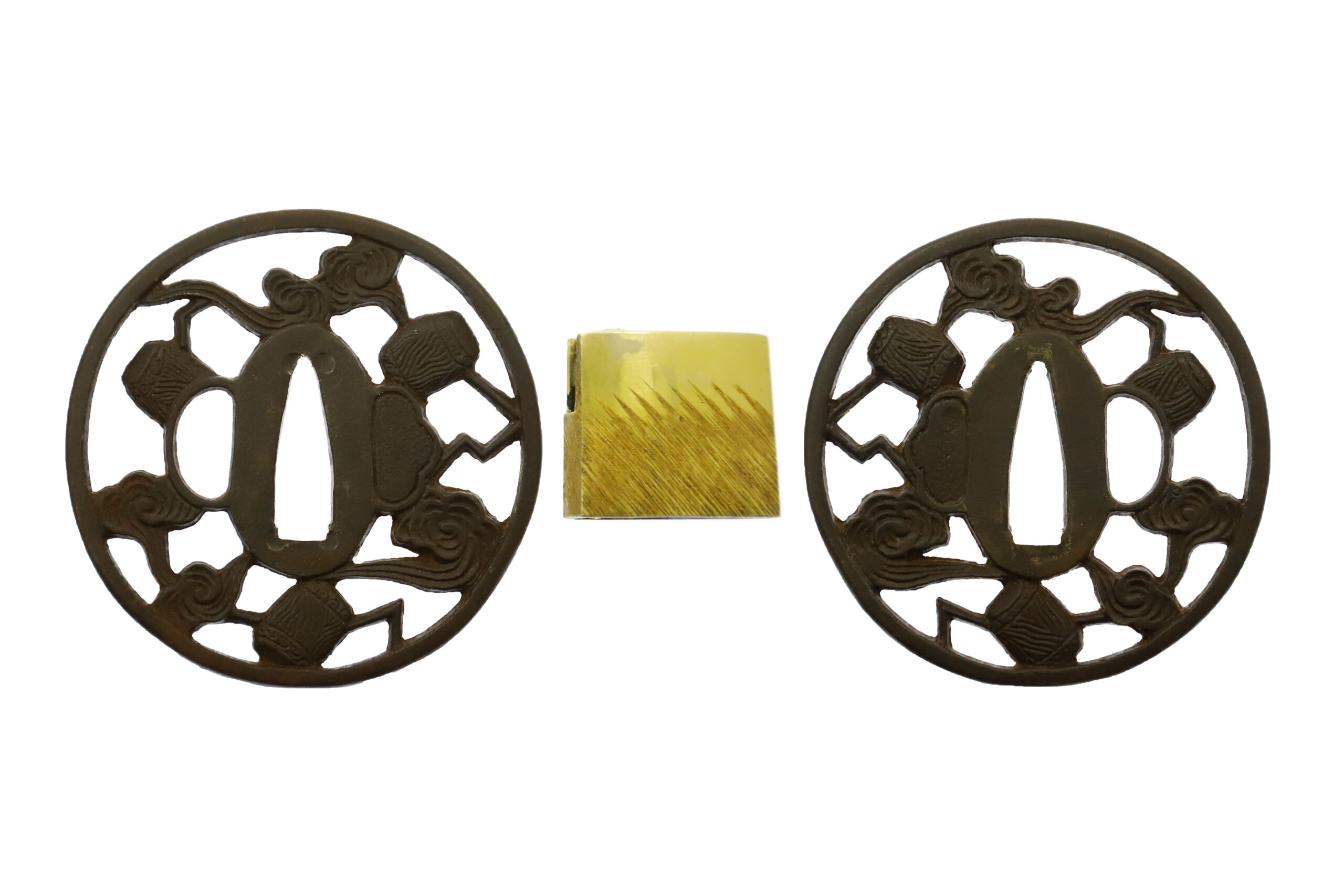
Saya: Saya is the scabbard for the Japanese sword.

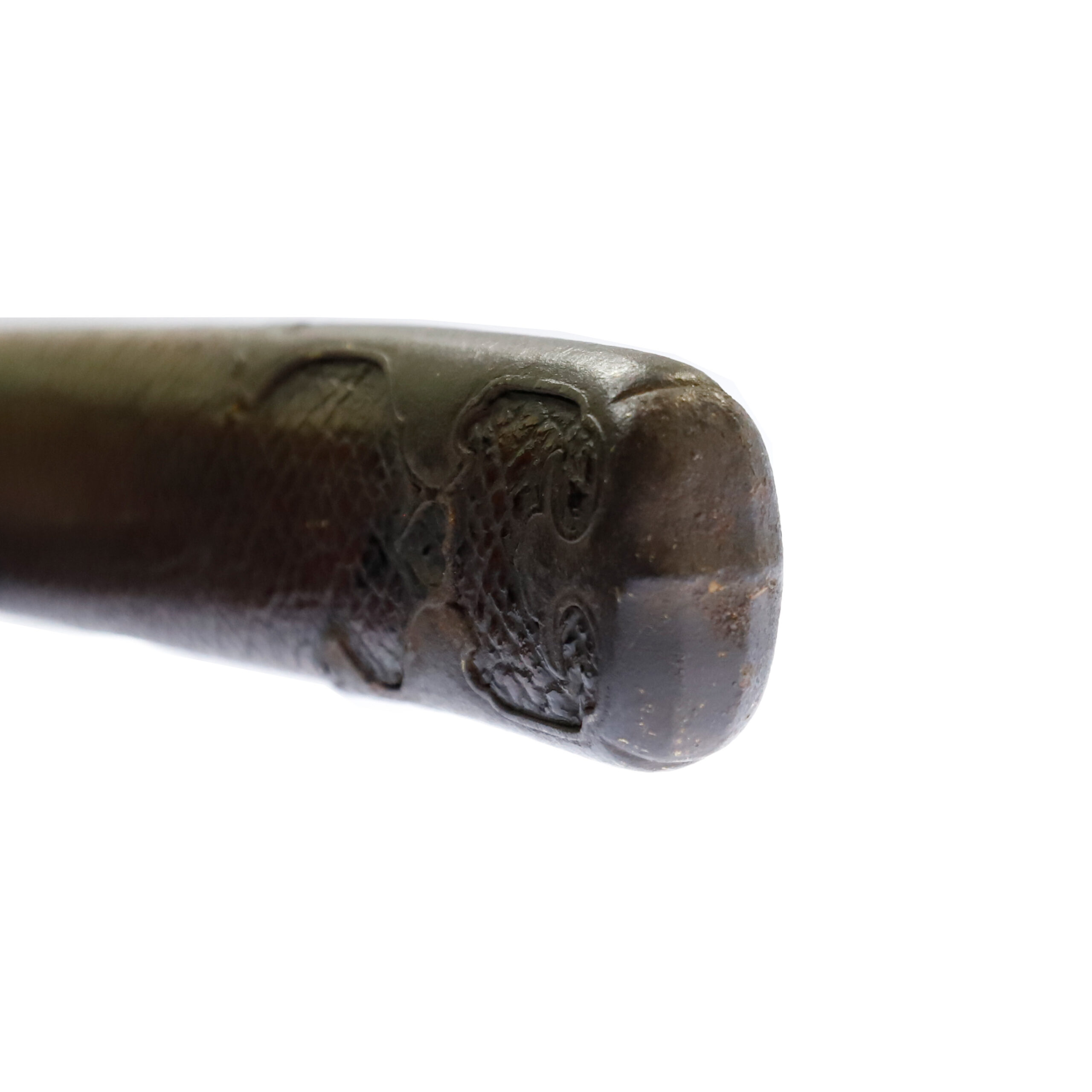
Authentication Paper: NBTHK Hozon Certificate for the blade (No.3012915)
NBTHK, also known as Nihon Bijutsu Touken Hozon Kyokai (the Society for the Preservation of the Japan Art Sword), is one of the oldest Japanese sword appraising organizations in modern-day Japan. They authenticated the blade on July 21th in the 28th year of Heisei(2016). They appraised it as Hozon Touken, the blade worth preserving for Japanese society. The purchaser will receive this original certificate as well. We can also translate what is written into English and make a PDF file for your record if you request.
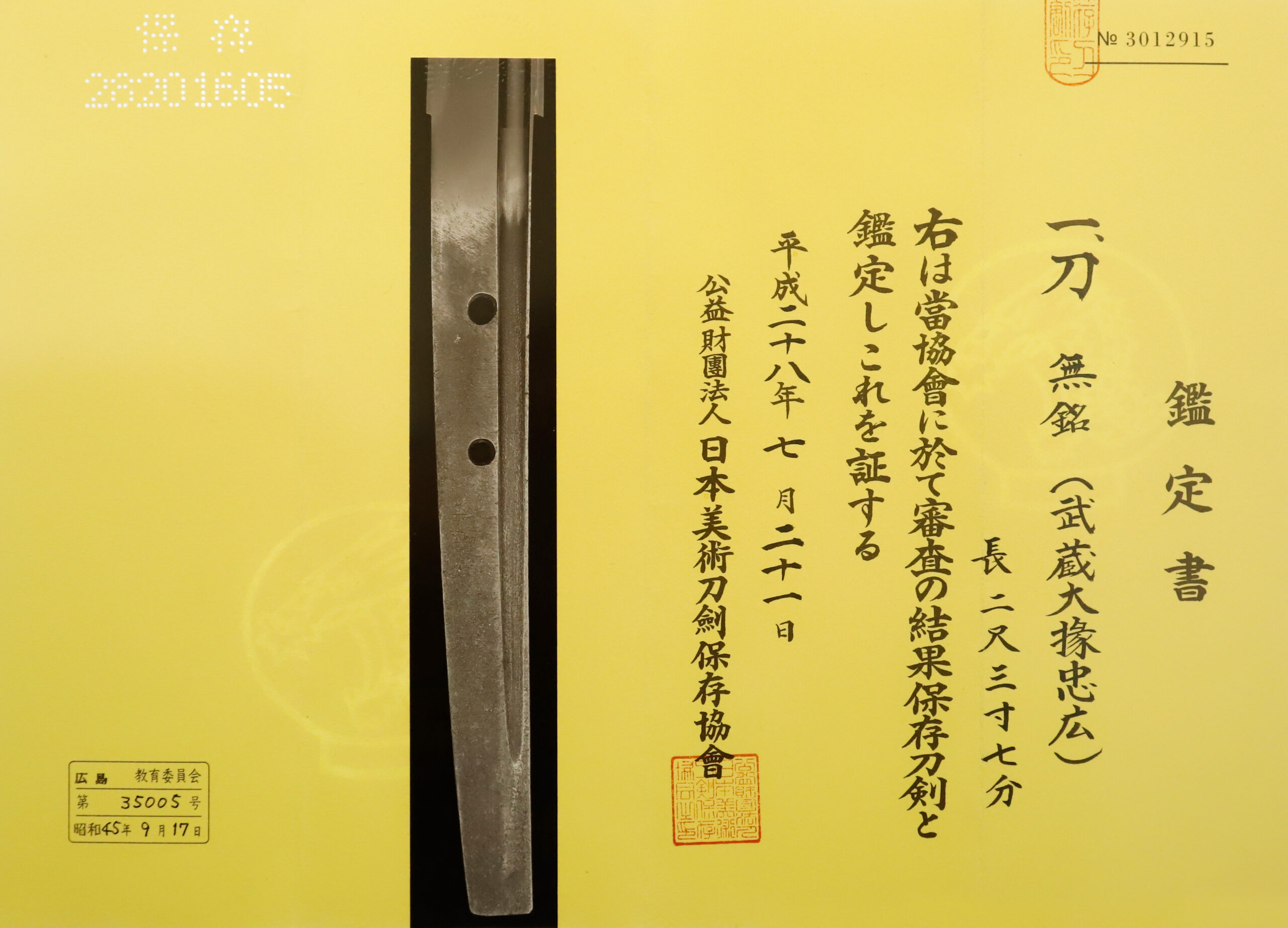
Registration Number: Hiroshima 35005
The Board of Education in Hiroshima prefecture issued a registration paper for this sword. It is called Jyu Token Rui Torokusho (銃刀剣類登録証). Bunkacho (The Agency for Cultural Affairs) acknowledges a Japanese sword with this paper as a work of art.
The sword needs to be traditionally hand-forged and made of Tamahagane carbon steel to be registered in the system. With this paper, its owner in Japan can legally own an authentic Japanese sword. Based on this registration number, we will apply for its export permit.
This paper will need to be returned to the board of education when the sword is being shipped abroad, but you can receive a copy of it. An English translation of this registration paper is available on request.
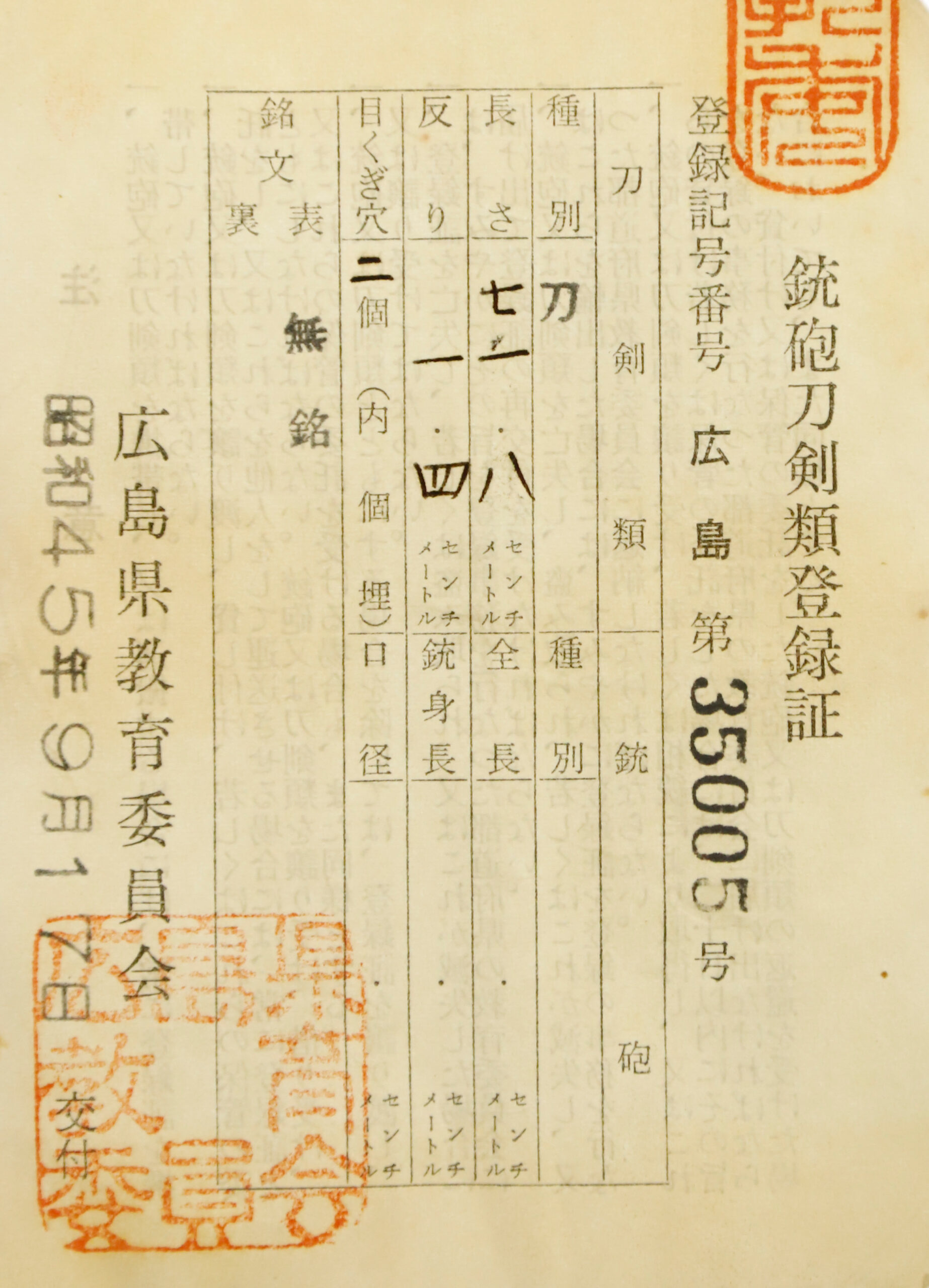

【About us】
Samurai Museum is located in Tokyo, Japan, exhibiting antique artifacts related to the Samurai history. Samurai Museum Shop is the place for those who are interested in Japanese culture and craftsmanship. We deal with antique Samurai swords/armor, traditional crafts made in Japan and so on.
【Japanese Sword& Export Process】
The Japanese swords we deal with are hand-forged edged swords made in Japan. It was made from the traditional carbon steel called TAMAHAGANE(玉鋼). Samurai Museum is familiar with the proper legal procedure for an antique/ authentic Japanese sword to be exported from Japan. We have sent more than 700 Japanese swords for the past few years (~2024) to amazing owners who appreciate its historical value.
Each Japanese sword is registered under the Agency for Cultural Affairs and the Board of Education in Japan. They issue a registration paper for each Japanese sword for its owner in Japan to legally possess it. The Japanese sword with its registration paper means it was traditionally hand-forged in Japan.
To legally export the sword from Japan to other countries, we will have to apply for its permit to the Agency for Cultural Affairs(Bunkacho) and return the original registration paper to the Board of Education. It normally takes around 2-4 weeks to receive this permit after submitting required documents. And we would like you to expect at least 1-1.5 months for your order to arrive at your given address after you ordered. For more detailed info, please click here.
It is allowed for residents in Japan to own authentic Japanese swords without a special license as long as they come with registration papers. Please feel free to contact us if you are a resident of Japan, whether temporarily or permanently. We will also assist you when you leave Japan and need to obtain the export permit.
【Payment Method】
We accept payment through Stripe (Credit card), PayPal, Apple Pay or ChromePay, all of which are secure payment methods. Also, you don’t need to make an account on Stripe for the checkout. If you prefer other payment method, please contact us. After confirming your payment, we will apply for an export permit. You may either pay in JPY, USD, AUD, CAD,EUR CHF or GBP. The price is set in Japanese Yen. Prices in other currencies are automatically calculated based on the latest exchange rate.

* If the amount is above 1 million JPY, Stripe or wire transfer will be the only options for payment.
【Shipping】
We have shipped authentic Japanese swords to the USA, UK, Canada, Mexico, Germany, France, Hong Kong, Finland and Australia. If you don’t live in these countries and like to order, please contact us first before making a purchase. We offer Free International Shipping as long as we can send antique Japanese swords by EMS.
We normally ship by EMS(Express Mail Service) provided by Japan Post. We will send you a tracking number for your order as soon as we hand it to the post office. We will put 100 % insurance on the shipping document without any extra charge. Based on the total amount, there might be a duty tax or other fee for you to pay, depending on the countries. We use package cushioning to protect the item and put it in a PVC pipe, which is one of the most secure packages because of its durability.
It will normally takes 5-14 days for the item to arrive at your given address after we dispatch it. Time of delivery is estimated as accurately as possible by the carrier but does not take into account any delays beyond our control such as by inclement weather, post office holiday seasons.
* If you live in Australia and like to purchase an authentic Japanese sword, please click here to know the detail.

【Review】
Here is one of the reviews we received from a customer who purchased an authentic Japanese sword from us. For more reviews, please click here.
“My experience overall with the whole process was wonderful. I had many questions about the history and process to purchase these treasures. All my questions were answered very timely and complete. The staff is very knowledgeable and very well versed if any questions do arise.”
【How to make sure the condition】
Please keep in mind that what you are going to purchase is an antique item. We uploaded high resolution photos for you to check its condition thoroughly. If you like to see more photos with different angles, please feel free to contact us. We will be happy to send them to you so that you can make informed decision. It is essential for us to know that you are happy with your choice of a sword. and we are prepared to use the best of our ability to serve you.
【How To Contact Us】
Please contact us through email, Facebook Messenger or Live Chat if you have any questions. You can find each icon on the right side of the website. Please click one of them to reach us. We will reply to you within 1-2 business days.
【The Art of Nihonto (Japanese Sword)】
Samurai’s history is a profound, eloquent legacy of ancient Japanese warriors in which millions of people worldwide are being fascinated. If you like to find out the art of Nihonto, please click here.
【A Guide to Japanese Sword Maintenance】
After acquiring an genuine Japanese sword, it is also important to know how to take good care of it. Here is the special video for you. Mr. Paul Martin, Japanese sword expert, shows you how to give proper maintenance to your sword. By mastering how to clean the Japanese sword, its aesthetic beauty will last forever.
When you purchase a Japanese sword from us, you can get a Free Japanese sword maintenance kit. It comes with four tools(Choji Oil, Uchiko Whetstone Powder, Peg remover, Oil Applicator). By watching the video instruction above , you can enjoy learning how to maintain your Japanese sword while appreciating it. If you have any difficulty assembling the sword or cleaning the blade, you can feel free to contact us.


MORE ANTIQUE JAPANESE SWORD FOR SALE
SWORDS WITHOUT CERTIFICATES FOR SALE
LEARN JAPANESE SWORD TERMINOLOGY
Thank you for reading all the information on the page. If you have any difficulty choosing the right Japanese sword for you, we will be more than happy to help you find the one that speaks to you the most. Please feel free to contact us.
